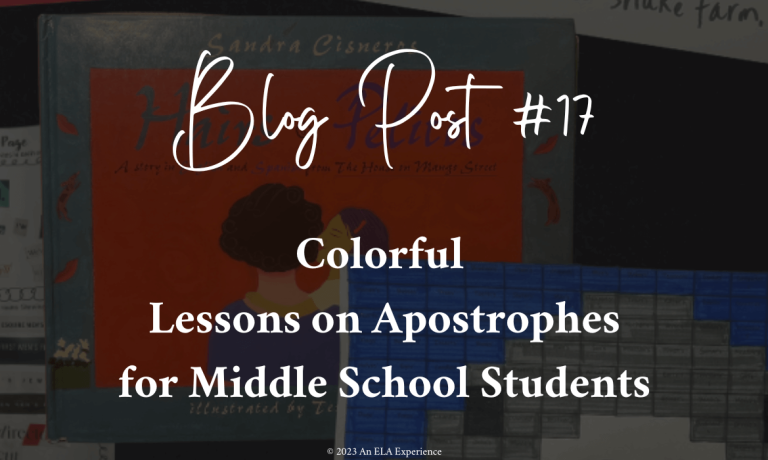Imagine teaching lessons on apostrophes and scanning your classroom to see every student on task and engaged. I can’t promise this will happen when you’re covering the rules, but you will notice this when you gather students around you for a picture book reading, when students write sentences about family members’ hair, when they collect words from magazines, and when they work on a color-by-apostrophe activity.

Lessons on Apostrophes–The Rules
Like all punctuation marks, apostrophes are easier to use correctly when writers know the rules. This isn’t particularly entertaining, unless you’re a grammar geek, but it’s a fairly quick process since apostrophes are only used in three ways (to show possession and to form contractions and some plurals). Plus, most middle schoolers know their contractions, and the plural form isn’t used often.

This is why I begin by reviewing the rules with examples and visuals. I start with a slideshow that reviews apostrophe rules and give students handouts to keep in their writers’ notebooks for easy reference. I then move on to the activities.
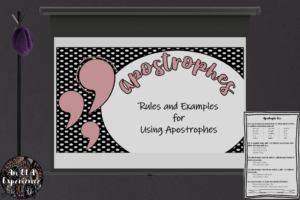
Apostrophes with Contractions
When teaching, it’s a good practice to start with what students know and build on it, so I begin with contractions. I say they know this rule, and they do for the most part, but they still make mistakes.
Some students need to be reminded to include an apostrophe when writing contractions. Most students will need a minilesson on its versus it’s. They should also remember to avoid using contractions in formal writing.
Give students the rule for using apostrophes with contractions:
Apostrophes are used in contractions to show where letters or numbers are omitted.
Then demonstrate how contractions are formed by crossing out the omitted letters and replacing them with apostrophes.
Examples
are not = aren’t
could not = couldn’t
he will = he’ll
I have = I’ve
it is = it’s

Make sure to review its versus it’s in detail. Since apostrophes are used to indicate possession, students understandably want to use it’s to show possession, but they’ll need to use the possessive pronoun its (just as they would your or their). It’s is a contraction for it is or it has and does not show possession.
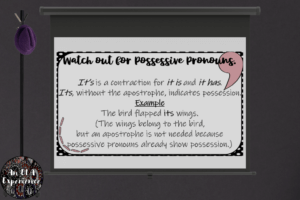
Students can check to see which form they need by breaking down the contraction and replacing the word in question. For example, you don’t want to write “The squirrel chased it’s tail” because that would read “The squirrel chased it is tail.”
Apostrophes that Indicate Possession
Apostrophes are also used to show possession. Students will need the most help here since the rules differ depending on whether a singular or plural noun is used.

For a singular noun, add ‘s to indicate possession, even when the noun ends in s.
Examples
A butcher’s shop. . .
The princess’s decision. . .
A cat’s promise. . .
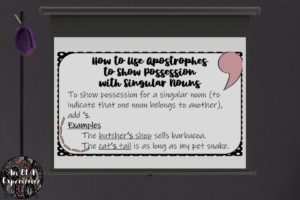
This is true for singular proper nouns too (e.g., Carlos’s hair, Luis’s hat).
For plural nouns that do not end in s, add ‘s to indicate possession.
Examples
The women’s houses. . .
Oxen’s tails. . .
Children’s menus. . .
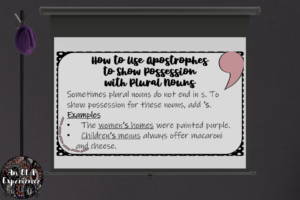
For plural nouns that do end in s, just add an apostrophe to show possession.
Examples
The foxes’ counsel. . .
Five queens’ husbands. . .
The flamingos’ grunts. . .

Apostrophes with Plurals
Apostrophes are used to form the plurals of letters (although you probably won’t run into this very often).
Examples
Mississippi has four s’s.
Melissa made four A’s on her report card.
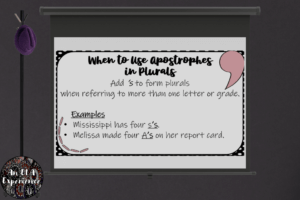
Word-Collecting Lessons on Apostrophes
After discussing the rules for apostrophe use, continue the lesson by collecting words with apostrophes. Students can collaborate in small groups to hunt for apostrophes, and their words can be added to an anchor chart for easy reference during class.
I use a variation of an activity from Jeff Anderson’s Mechanically Inclined. (If you’ve read some of my other posts, then you know I’m a fan of Anderson because he knows how to engage students.) He calls this one Apostrophe-thon and has students highlight and categorize words that show possession or contraction, including ones that do not have apostrophes, from the beginning pages of Paul Fleischman’s Whirligig. Of course, you can do this with any text you’re reading that includes apostrophes. Students will find success (and confidence) when using texts that include what they’re looking for.
I do something similar with magazines. Students skim headlines, snipping words that include apostrophes. If they show ownership, then they also cut out the words that follow (the things that are being possessed along with descriptors). They then paste these words onto a handout that includes boxes for contractions, singular nouns showing possession, and plural nouns showing possession.
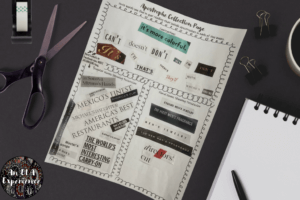
You can do this on butcher paper too and create anchor charts by having students divide the paper into three to four sections, depending on what you’re having them look for, and writing examples in each box. They can quote from their reading and their own writing and add them to the chart today and in the upcoming weeks.
Lesson on Apostrophes with Contractions
I Have Who Has, an Apostrophe Game
If you have students who need practice with contractions, play a game of I Have Who Has. Insert an 8 x 2 table onto a slide with a custom 8 ½ x 11-inch size (in the U.S.). This will give you eight cards.
On the first card type, “I have the first card” on the top of the card and “Who has the contraction for are not?” at the bottom of the card. On the second card write “I have aren’t” on the top half of the card and “Who has the contraction for cannot?” on the bottom half. Continue doing this until you have enough cards for your largest class.
When you’re ready to play, give each student one card (two if you have more cards than students), and start playing.

A Lesson on Apostrophes for Possession
Hairs, a Picture Book for Teaching Apostrophe Use with Names
I’ve been using this activity for so long (because it is that good) that I thought it was my idea, but I searched my books and found it in Jeff Anderson’s Everyday Editing. Surprise, surprise. (This book usually runs for $28.00 on Amazon, but it’s on sale for $10.00 at the time of this writing!)
Read and discuss.
Gather your students around for a reading of Sandra Cisneros’s Hairs, a sweet picture book with lines like “. . . my mother’s hair. . . is the warm smell of bread before you bake it. . . .”
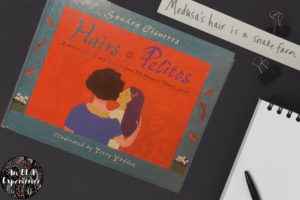
Since it’s written in Spanish and English and I have many students who speak Spanish, I usually read the parts that are written in English and a volunteer reads the lines in Spanish. As we read, we discuss the use of apostrophes and figurative language, including adding ‘s to a singular proper noun that ends in s (Carlos’s hair).
Write.
I then direct students to write one sentence each about a family member’s hair that uses both a simile and an apostrophe showing possession. (Some will want to write about a pet’s hair, and that works too.) What’s great about this activity is that most students’ sentences will include similes even when I neglected to include that detail in my instructions. (Still, I started instructing them to use similes so that every one of them would have fabulous sentences.)
As students finish writing their sentences, they bring them to me for a quick check and conference. (These will go on our classroom walls, so I want them to be error-free.) They then write their sentences on sentence strips with markers and tape them on a wall chart (e.g., a sheet of butcher paper titled “Apostrophes that Show Possession”). Of course, we want to close the lesson, so I have volunteers share their sentences, which I quiz them on by asking simile and apostrophe-related questions.
Lessons on Apostrophes for Possession and Contractions
Apostrophe Quiz Slideshow
Create a multiple-choice slideshow that quizzes students on the various ways to use apostrophes. For this one, I removed the backgrounds on pictures of the various pets in my family and wrote sentences about them.
Students can work individually or in small groups, holding up cards labeled A, B, or C to indicate their answers. For added engagement, host a contest and award students with candy or dollar-store prizes.

Apostrophe Coloring Page
If students finish work early, then consider having them complete a color-by-apostrophe activity.
The easiest way to do this is to take a page from a coloring book that can be completed with three colors. Write directions at the top of the page that instruct students to use specific colors for contractions, singular nouns showing possession, and plural nouns showing possession. Then write these words in the corresponding spaces, make copies, and stick them in a what-to-do-when-you’re-finished tub. (The tub idea came from a TPT reviewer; unfortunately, I’m not always organized.)
I didn’t make mine the easy way because I wanted to use pixel art to make it more challenging. To do this, insert a fifteen by fourteen table onto a Google or PowerPoint slide and stretch it so that it is as large as the width of the page. Then started drawing simple pixel images with four colors (including white space). Once a picture is created, type contractions into the spaces that will be colored in black, singular nouns showing possession in the spaces that will be colored gray, and plural nouns showing possession in the spaces that will be colored blue (or whatever colors you prefer.) Students are surprised to see the boxes become pictures!
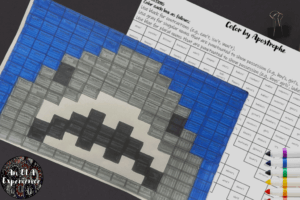
Related Links for Lessons on Apostrophes
Apostrophes for Possession PowerPoint
SUU Writing Center: Apostrophe
Lessons on Apostrophes in a Nutshell
- Review contractions with students to remind them to include the apostrophe and to clarify misconceptions (e.g., it’s versus its).
- Provide them with rules, visuals, and examples with a slideshow, handouts. and anchor charts.
- Have students collect, categorize, and display words that include apostrophes on handouts and wall charts.
- If students need to review contractions, play a game of I Have Who Has.
- Use Sandra Cisneros’s Hairs to teach students how to use apostrophes to show possession with singular nouns.
- When students finish classwork early, let them complete a color-by-apostrophe page.
- ALWAYS ask students to apply their learning to their writing.
I hope you and your students enjoy these lessons on apostrophes, and I thank you for reading!

